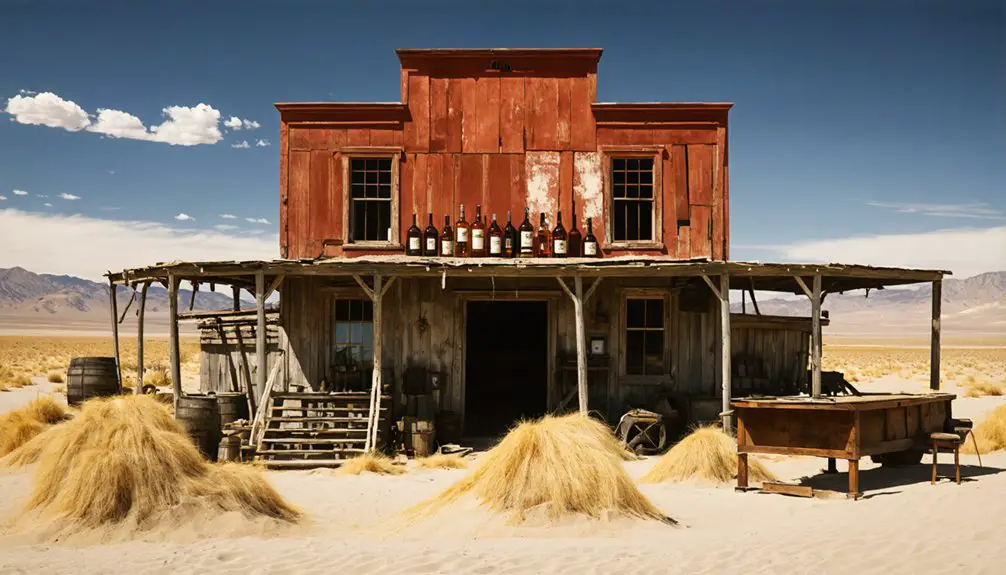You’ll find Louisville’s remains in Nevada, where it began as Lime Point in 1880 near limestone deposits. After silver’s discovery in 1902, the settlement transformed into Hornsilver and boomed with thirteen saloons at its peak. Located 250 miles from Unionville, early settlers faced extreme isolation and water scarcity. Today, only scattered ruins and mining debris mark where this once-bustling frontier town stood, each crumbling foundation holding stories of Nevada’s rich mining heritage.
Key Takeaways
- Originally established as Lime Point in 1880 near limestone deposits before transforming into a silver mining settlement in 1902.
- The town experienced significant growth during the mining boom, supporting thirteen saloons at its peak period.
- Dr. Nat S. Lewis, a prominent mining superintendent and physician, influenced the town’s development and inspired its name.
- High transportation costs, limited water resources, and isolation challenged the settlement’s sustainability and economic growth.
- Today, only scattered ruins, mining debris, and building foundations remain as evidence of Louisville’s mining town past.
Early Settlement and Mining Origins
Three distinct phases marked Louisville’s early settlement, beginning with its 1880 establishment as Lime Point near a prominent limestone outcropping.
You’ll find that initial settlement dynamics were shaped by ranchers and miners who braved the desolate terrain, facing significant challenges due to water scarcity and isolation. The nearest supplies were in Unionville, a staggering 250 miles away. The bustling town eventually grew to include thirteen saloons during its peak years.
The discovery of silver in 1902 transformed Lime Point into Hornsilver, triggering new mining challenges. By 1908, the population had grown to over 1,000 residents.
A pivotal silver discovery in 1902 reshaped Lime Point’s destiny, giving birth to Hornsilver and its mining struggles.
You’d have paid over $100 per ton to transport ore to Lida’s mills, 12 miles distant. While early mining efforts fizzled within a year, the Great Western Mine Company‘s rich silver vein discovery in 1905 sparked renewed interest, leading to the shift from tent camps to wooden structures by 1908.
Life in a Nevada Boomtown
As Nevada’s boomtowns rapidly expanded in the early 1900s, you’d witness an impressive transformation from basic mining camps into bustling urban centers.
You’d find yourself among thousands of fortune-seekers, as populations swelled to 25,000 in places like Goldfield and Virginia City. The community dynamics revolved around mining operations, where you could spot ornate stock certificates and glittering ore veins that drew prospectors from far and wide. Miners worked tirelessly in shafts where gold veins by candlelight were visible, making the wealth seem almost within arm’s reach. The wealth generated from these mines helped finance the Union Army during the Civil War.
Daily life centered around crucial social institutions – from saloons and theaters to union halls and merchants.
You’d walk on paved sidewalks past stone and brick buildings that replaced wooden structures, while electric street lights illuminated the nightlife.
Modern amenities arrived swiftly, with telegraph lines connecting you to the outside world and automobiles replacing covered wagons on the widened streets.
The Legacy of Nat S. Lewis

Among the notable figures who shaped Nevada’s mining history, Nat S. Lewis stands out for his remarkable influence on Louisville during the 1860s. As superintendent of the Techatticup Mine and the camp’s only doctor, his community leadership helped transform a rough mining camp into a structured settlement. Much like how King Louis XVI inspired Louisville, Kentucky’s name in 1778, Lewis’s impact on Nevada’s Louisville was profound.
The mining camp’s success mirrored Louisville, Kentucky’s role as a major shipping port along the Ohio River.
- Guided one of Nevada’s richest mines while providing essential medical care to miners and their families
- Earned such respect that the town of Louisville was named in his honor
- Combined rare management and healthcare skills that proved crucial to the community’s survival
Lewis’s influence extended beyond basic administration, as he tackled public health concerns and maintained worker safety in the remote Eldorado Canyon.
Today, though Louisville stands as a ghost town, his legacy endures as a reflection of frontier ingenuity and dedication.
Mining Operations and Economic Impact
While prospectors first discovered precious metals in El Dorado Canyon by 1857, Louisville’s mining operations flourished during the late 19th and early 20th centuries.
Colonel Vineyard established a ten-stamp mill that helped reduce ore processing and transportation expenses to San Francisco by half.
You’ll find that mining techniques evolved from simple placer gold and shallow lode extraction to more complex silver and copper operations. The town’s strategic location near the Techatticup Mine made it an essential hub for ore processing and transport. The mining boom reflected the Comstock-era production period of 1861-1889, which dominated Nevada’s early mining history.
Economic fluctuations heavily influenced Louisville’s fate. Though some nearby mines, like the Nevada Wonder, paid impressive dividends exceeding $1.5 million before 1919, the town’s prosperity remained tied to ore yields and market prices.
Despite lucrative mines like Nevada Wonder yielding millions, Louisville’s economic survival hinged entirely on the volatile mining industry’s success.
The Colorado River steamboat landings provided critical logistics support, but high transport costs and limited smelting capabilities ultimately constrained the settlement’s growth and contributed to its eventual abandonment.
Ghost Town Remains Today
The scattered ruins of Louisville tell a stark tale of abandonment in Nevada’s El Dorado Canyon.
Today, you’ll find only foundations, mining debris, and deteriorating stonework where a once-bustling mining camp stood. Located at approximately 35.7118°N, 114.8045°W, the site faces ongoing preservation challenges from desert weathering and erosion. Like the remnants at Upper Pyramid camp, extensive stonework ruins remain as testament to the mining era. The area echoes the broader trend of ghost town transformation affecting numerous Nevada cities in 2025.
- Rusted mining equipment and tailings mark the landscape, offering glimpses into the area’s rich mining heritage.
- Natural vegetation has reclaimed much of the former camp, which operated from 1861.
- No standing structures remain, though you can still trace building outlines through scattered foundations.
Your remnants exploration will reveal Louisville’s raw, untamed character – there’s no formal preservation, developed trails, or interpretive facilities.
The ghost town stands as a reflection of the freedom and impermanence of Nevada’s mining frontier.
Frequently Asked Questions
What Dangerous Wildlife Was Commonly Encountered by Louisville’s Residents?
You’d face deadly snake encounters around mines, with mountain lions prowling the remote hills. Coyotes scavenged near settlements, while rattlesnakes, bobcats, and scorpions threatened your daily survival.
How Did Residents Get Fresh Water in This Remote Desert Location?
You’d have gotten fresh water through distant pipelines, mountain springs, and treated wells, just like other Nevada mining towns that built extensive water sources and irrigation methods across harsh desert terrain.
Were There Any Notable Crimes or Shootouts in Louisville’s History?
While you’ll find general mentions of mining-era violence typical of Nevada camps, there aren’t any documented notable crimes or historical shootouts specific to Louisville in surviving records.
What Traditional Native American Territories Overlapped With the Louisville Settlement Area?
Ever wonder who first called this land home? You’ll find Southern Paiute territories dominated the area, while Mohave and Anasazi cultures left their mark. The Las Vegas Valley held sacred significance for these peoples.
Did Any Famous People Besides Nat S. Lewis Visit Louisville?
You won’t find records of other famous visitors or historical figures in Louisville beyond Nat S. Lewis. While miners and prospectors frequented the area, no other notable personalities are documented in historical accounts.
References
- https://kids.kiddle.co/Louisville
- https://thisisreno.com/2015/07/explore-nevadas-mining-history-in-these-three-ghost-towns/
- https://en.wikipedia.org/wiki/Louisville
- https://nevadamagazine.com/issue/winter-2024-2025/25048/
- https://savingplaces.org/stories/explore-wild-west-mining-history-in-nevada-ghost-towns
- https://www.legendsofamerica.com/nv-goldpoint/
- https://www.goldpointghosttown.com/HTML_Pages/History.htm
- https://travelnevada.com/ghost-town/ghost-towns-near-reno/
- https://nvtami.com/2022/11/13/humboldt-pershing-county-ghost-towns/
- https://nevadamagazine.com/issue/winter-2023/23064/



